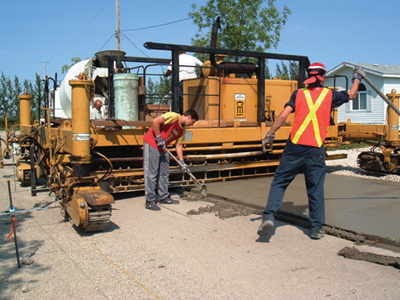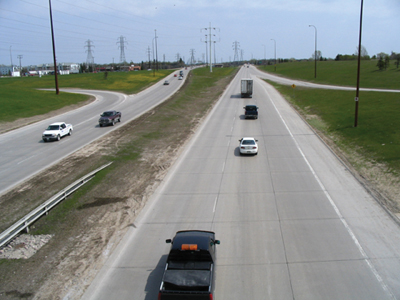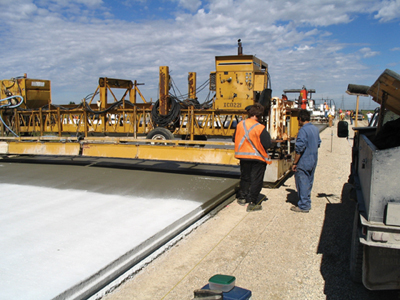
It’s been some 80 years since the first concrete street pavement was
poured in suburban Winnipeg. Since then, municipal and provincial
engineers and the general public have recognized that concrete streets
and roads serve them well in the difficult climate of the Red River
Valley.
It’s been some 80 years since the first concrete street pavement was poured in suburban Winnipeg. Since then, municipal and provincial engineers and the general public have recognized that concrete streets and roads serve them well in the difficult climate of the Red River Valley.
 |
|
| Slip-form pavers are a common site in southern Manitoba.
|
“Manitobans don’t really recognize how unusual it is for any local region in Canada to have such a concentration of concrete pavements,” says Todd Kruszewski, Director of Marketing and Technical Affairs for the Cement Association of Canada. “Concrete pavements are so commonplace there that even homes don’t sell well unless the driveway is concrete.”
Some 4,600 lane-kilometres of concrete pavement are in service in Winnipeg residential streets, another 680 lane-km in back lanes and 1,600 lane-km more on arterial roads. Developer agreements signed with Winnipeg City Hall specify “150 mm of concrete pavement or equivalent” for all suburban streets. Only rarely is the flexible pavement option taken up because it can mean high maintenance costs for the developer. The cities of Winkler, Morden, Steinbach and Altona also routinely pave their streets with concrete.
 |
|
| Some 4,600 lane-kilometres of concrete pavement are in service in Winnipeg residential streets, another 680 lane-km in back lanes and 1,600 lane-km more on arterial roads.
|
Over 110,000 cubic metres of ready-mix concrete are poured each year in the region for streets and that total does not include the 20,000 or more cubic metres used each year on nearby highways for the Manitoba Infrastructure and Transportation (MIT) Department. The 2009 and 2010 MIT highway paving seasons are likely to see a further 54 lane-km paved in concrete on the Trans-Canada Highway east of Winnipeg.
The typical depth of concrete for residential streets is 150 mm, although Winkler has also had success with 125 mm thick street pavement. Some 50 km of provincial roads in the region, built in the 1960s, are 150 mm thick, plain and undowelled. These roads have stood up well, although several of them are submerged frequently in the regular spring flooding of the Red River upstream of Winnipeg. The current typical design for highways such as Provincial Truck Highway 75, which connects with Interstate 29 in North Dakota, as well as the Trans Canada Highway, is 250 mm of plain concrete with dowels at the joints for extra load transfer. The granular base is typically 100 to 150 mm thick on top of the compacted clay subgrade. In street work, this means reduced excavation and lower base course costs than the flexible pavement alternative.
For a number of years, both the city and provincial engineers had included a unique so-called “elastic joint” in the slabs consisting of reinforcing steel mats of 15M smooth steel bars spaced at 500 mm in both directions within the slab. An extra 300 mm length of these bars protrudes into the adjacent panel, substituting for dowels. This design is still used on some residential streets, but other, more effective and economical, options such as plain (unreinforced) slabs with or without dowels are increasingly used.
 |
|
| At least five experienced contractors have the skills and apparatus to handle the volume of concrete work in the region.
|
The concrete mix specified is 32 MPa and air-entrained. Fly ash is routinely incorporated into the mix to enhance durability and reduce the carbon footprint. By instigating a requirement for so-called “Three bin mixes” some eight years ago, thereby adjusting the aggregate gradations by incorporating mid-size coarse aggregate, the Winnipeg mixes showed an improvement in finishability, resulting in reduced scaling from over-finishing during placement.
The demand for concrete is met by some seven ready-mix companies, several of which have satellite or portable plants ready to dedicate to any large pavement project in the city or on a provincial highway. The City requires submission of all mix test data, such as strength and air void tests, each winter prior to approval for next season’s work. The Province, on the other hand, utilizes prescriptive specifications and determines mix proportions itself.
Construction of this high volume of concrete streets and roads each year has led over the decades to the development of local paving contractors with the necessary equipment and crews to do the job. While the City’s own Streets Department constructs a small portion of the pavement each year, at least five experienced contractors also have the skills and apparatus, typically slip-form pavers, to handle the jobs. In past years and even today for smaller sections and odd-shaped pours, simpler paving equipment has been utilized, such as vibrating screeds riding on forms or on pre-placed curb and gutter sections.
This article was submitted by the Cement Association of Canada.
Print this page